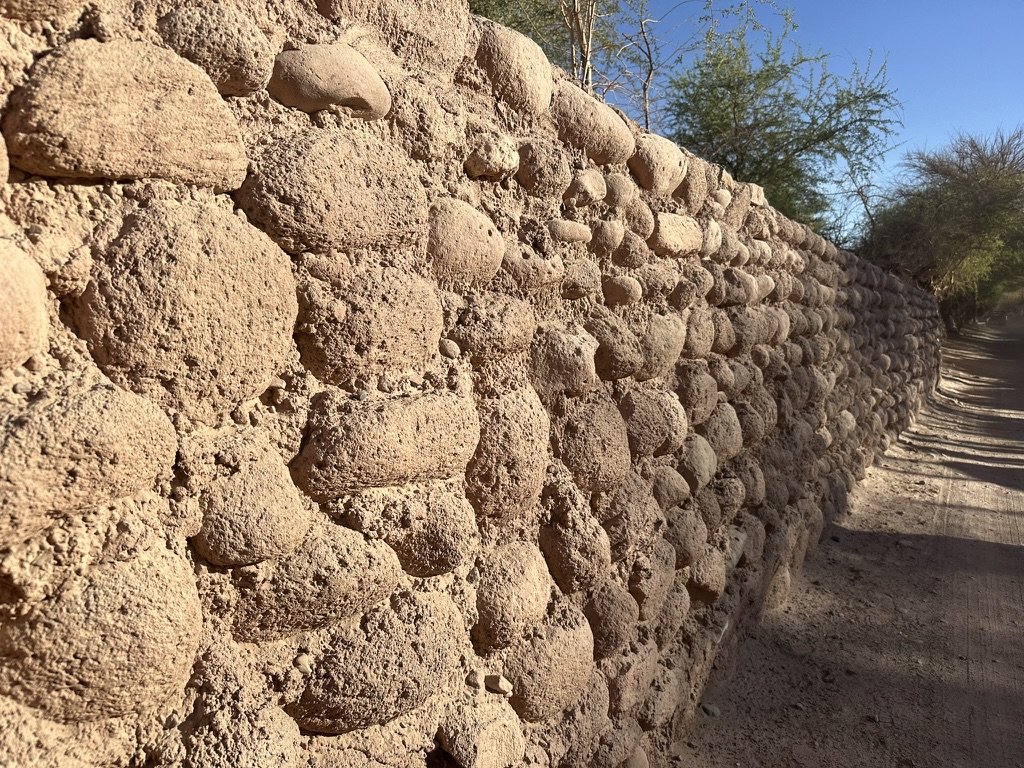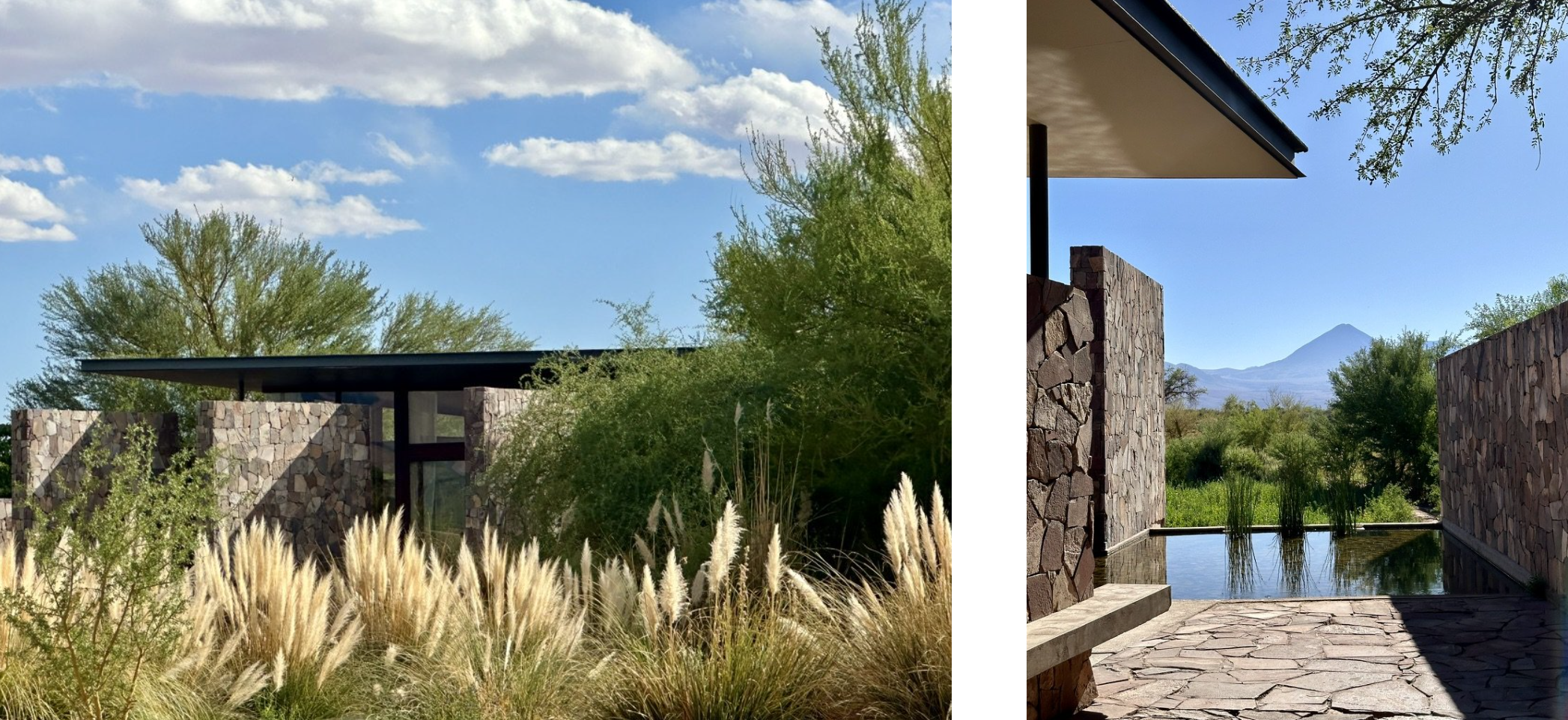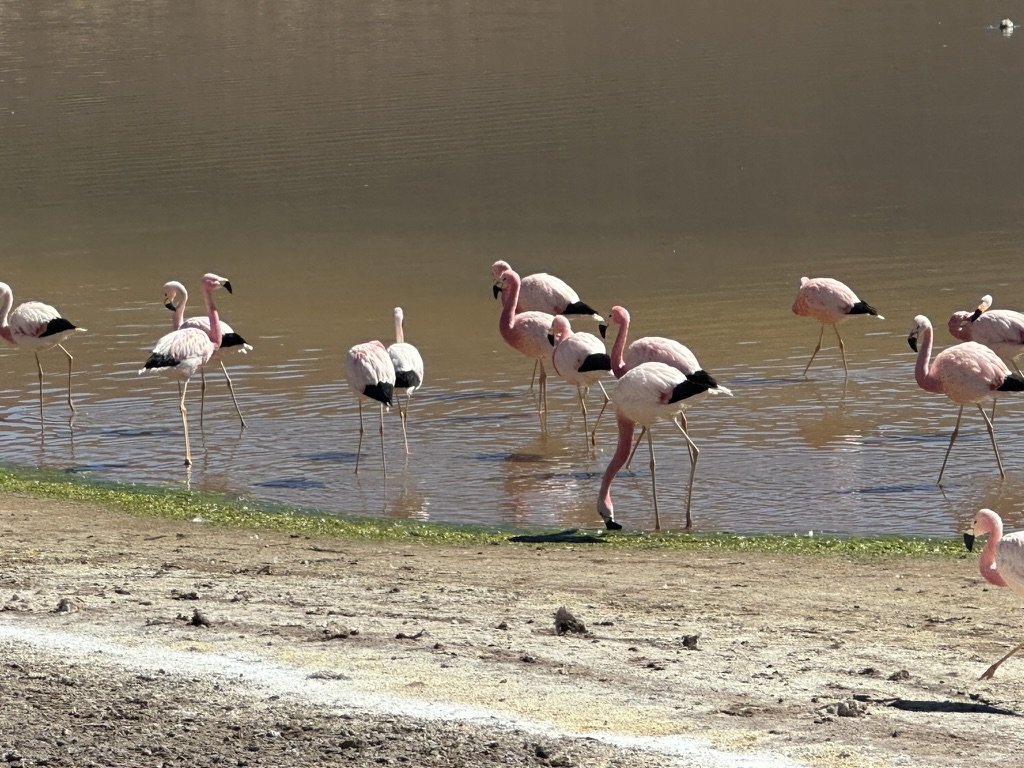Atacama Desert: From Salt Flats to Starry Skies
It’s late October when our plane touches down in Calama, the trailhead to Chile’s Atacama Desert, the driest nonpolar desert in the world. Our driver takes us past lithium and copper mines, ramshackle houses, dusty hills, wind farms, and rows of solar panels. For long stretches there’s nothing but sand and more sand. It’s scenic, dramatic, otherworldly. So much so that we are not surprised to hear from our driver that some scenes from The Mandalorian were filmed here.
After an hour, we arrive in the charming pueblo of San Pedro de Atacama, built with stone walls made of mud and straw. “The lodge is just up ahead,” says our driver. Our excitement builds as we bump along the dirt road passing verdant fields irrigated by a nearby river. At Tierra Atacama, our home for the next six days, we are immediately struck by the service and design, which are of the highest standard. This is the sister hotel to Tierra Patagonia, which I visited with my daughter Roxy a few years ago. I have such fond memories of that place, and I am eager to experience their desert outpost with my sweetheart, Brian.
As we walk toward the lobby’s floor to ceiling windows, we are drawn in by the dramatic view. A volcano rises in the distance against a plant-rich desertscape. Wild grasses golden, thick, and feathery line the swimming pool. The spa bubbles under the shade of tiny leaf trees with peeling bark. Birds sing and fly all around us. We are given welcome cocktails and an opportunity to meet some of the guests who, just like us, are true adventurers who have been everywhere and are thirsty for more.
“This is where they filmed Star Wars,” our guide informs us.
We start with a tour of desert highlights. Stark and mars-like, our first stop is to a salt mountain range. The landscape is comprised of sand and selenite (plaster glass), which glitters in the sun. It certainly looks like a land far, far away. We walk up and down the mountains taking in the great Andes Mountains in the distance and sandy dunes in the foreground. The place is a marvel.
We come across an abandoned luncheonette—the shell of a school bus that’s been in the same spot for more than forty years. It once served the miners who excavated the abundance of salt. Painted and peeling, tagged and torn apart, the bus looks out of place and somehow part of the scenery all at once. Brian and I climb aboard and pretend it’s our own magic bus that’s brought us here.
At 6am, when our next excursion begins, we are served fresh coffee and the promise of a breakfast picnic next to the Tatio geyser field. After a long climb in the lodge’s shuttle to a staggering 14,170 feet above sea level, we come upon a surreal site: dozens of powerful geysers that steam and sputter. We snap incredible pictures of the sun bursting through the steam as it rises up against the mountains that sparkle like diamonds.
In the afternoon, Brian rides a fat-tire mountain bike to a salt pan and dead sea, while I hike over waterfalls and along clear streams. I scale wet slabs of rock and scramble-up boulders. There are moments I am hanging by my fingers trying to find my footing all the while, imagining a spectacular fall into the river below. But I make it as do fellow hikers Joe and Michelle from Sydney, Australia. Michelle, who has rarely hiked bravely goes forward. When I ask her if she is scared, she answers, “Terrified.”
The landscape is dotted with wild grasses, moss, cactus, flowers, and hundreds-year-old saguaros. Our guide tells us the canyon holds one of the richest cacti eco-systems on earth. Up on the ridge, there are wild donkeys, a remnant of the old mining days. Replaced by trucks and jeeps, these donkeys have survived the harsh climate and thrived. At the end of our hike, we too have survived. Our adrenaline is firing, and we feel triumphant and incredibly hungry as we travel back to the lodge.
Each day we are eager to see what the Tierra’s inventive chef has prepared.
Brian and I indulge in a slow cooked masterpiece, a succulent lamb shank seasoned with a harmonious blend of savory herbs that effortlessly melts in our mouths. We linger over a glass of wine before heading out to Rainbow Valley; aptly named for its mountains of red, green, and white. At 9800 feet above sea level, the colors show the richness and different concentration of clay, salts, and minerals. We have a great time with our group climbing on the rock formations, carved by wind and rain, and posing for pictures against all the tricolors made even more vivid by the cloudless blue sky.
Back at the lodge, it feels like summer camp. Our shared experiences have bonded us with the guests. After cocktails, we head out for Awasi, a Relais & Chateaux located in the pueblo. Coincidently, our friends are staying there and have planned a special dinner for us. We are treated to a delicate preparation of crab legs wrapped in a single thin slice of cucumber followed by perfectly grilled large shrimp with local vegetables. Tres leche cake and homemade ice cream complete the utterly luscious meal.
We awake the next morning feeling the effects of too many wine pairings and Chilian Pisco Sours. In our reduced state, we figure the best excursion option is the thermal springs. We travel there by shuttle with Phillipe from Paris, his farther Mario from Bogotá, and Patricia and Mike from Louisville, Kentucky. The shuttle takes us across the barren desert and high up into the mountains on gravel roads past herds of llama, still fat and fluffy in their winter coats.
I have never seen such beautifully appointed natural thermal baths. Eight in all, each at varying temperatures, they are clear and clean flowing into pools from a cascading waterfall. A true desert oasis, the pools are connected by a series of wooden staircases and ramps that berm into the natural setting of the valley. We spend two hours soaking, taking pictures, and talking about our very different lives and of course, where we all want to travel to next.
Back at the lodge, we drink Chilian Sauvignon Blanc (a.k.a., hair of the dog), and devour fresh picked salads. Peas, fava beans, sliced celery, delicate lettuces need nothing more than a splash of good green olive oil and vinegar. It’s surprising what they manage to grow in the desert. Another surprise is the fresh seafood that’s brought to the lodge daily. Muscles, shrimp, clams, octopus, and fish arrive from the interior lakes and Pacific Ocean that line the coast of Chile, which, fun fact, is as long as the United States is wide. After lunch, I bathe in the hotel’s spa and then promptly fall asleep on the massage table--the perfect way to recharge after a week of action.
Our time in Atacama ends far too quickly and soon we are in the shuttle going back to the airport. I rewind the tape and flash on the pueblo of San Pedro, the stone walls made of mud and straw and the stunning views from Tierra Atacama, the volcanos that turn pink at sunset, the steaming geysers, pink flamingos, fluffy llamas, deep blue sky, star-filled nights, flowing waterfalls, and streams. What a wonder this place is… a desolate beauty, a playground, a paradise.















